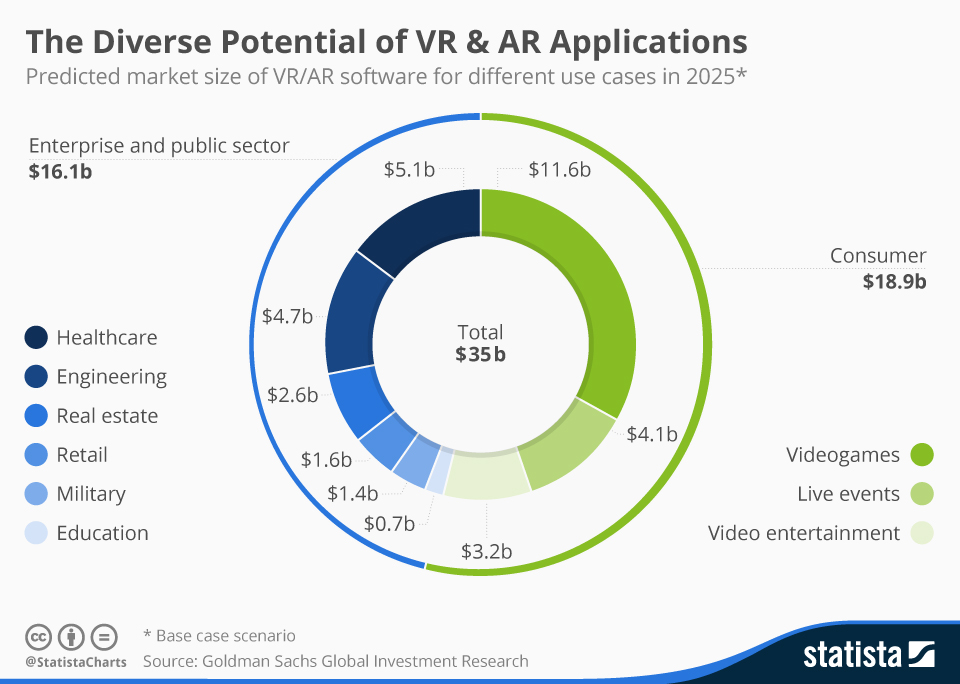Such digital technologies as virtual reality (VR) and augmented reality (AR) are more often associated with the world of video games and entertainment. VR immerses users into a new world, and AR, in its turn, enhances the current reality. The fact is that in recent years AR and VR have had a significant impact on the ways of how we buy and sell.
The real estate sector was not standing aside from the growing interest in these technologies. Many efforts have been spent to leverage the use of AR/VR in order to build cutting-edge, immersive experiences for the clients. Adopting the approach specifically for the entertainment industry, real estate agencies have reached a whole new level of emotional involvement. Instead of providing a long list of properties along with further explanations, the use of AR/VR can create a feeling of walking through the building that can become a client’s future home.
Such an approach to the real estate may seem a temporary and passing phenomenon, a new shiny toy for the tech-savvy clientele, but according to Goldman Sachs, 1.4 million registered real estate agents using AR/VR for prospective clients leading to an aggregated real estate commissions market of $107 billion. In this article, we’ll look at how AR/VR technologies change the usual course of things in the real estate business.
How AR/VR Work in a Nutshell
Once a product of science fiction, nowadays, virtual reality is more accessible than ever before. A wide range of devices allows users to interact with a three-dimensional, computer-generated environment. VR headsets can be used for generating visualizations and sound effects, allowing users to immerse themselves in virtual reality. AR, on the other hand, is an enhanced version of reality to add digital information on top of a captured image or video.
Augmented reality is typically available in mobile apps, the most popular of which is probably the Pokemon Go game. Such apps use the smartphone or tablet camera to capture videos of the real world. Then, they add a layer of information that can include text, images, and virtual 3D objects.
Years of evolution led to the emergence of a large number of various AR/VR devices of different purposes and price categories, starting with Google Cardboard (the minimal price is $5.71 plus the price of a compatible smartphone), and ending with Microsoft Hololens ($3,500 per device). Such diversity provides a wide range of possibilities for real estate agencies. Clients can access the services of a real estate company remotely via the website or by visiting the real estate agency in-person. In the second case, the client’s experience depends on the capabilities and ingenuity of the company. AR/VR content can be accessed via virtual headsets or even large touchscreens installed in the office.
Applications of AR/VR In The Real Estate Business
The range of possibilities that the use of AR/VR in real estate can provide is way broader than replacing the “FOR SALE” plate with something more sophisticated and eye-catching. Even before the house is built and long after it was bought by a happy customer, custom real estate solutions can be used for promoting your goods and services. To see how it can work, let’s take a look at some examples.
Visual Architecture
It may be hard to make a potential customer invest when the house exists only in the drawings and in the architect’s mind. It’s difficult for a buyer to picture something that hasn’t been built yet, and therefore, a spark of emotions cannot ignite. Showrooms with models of future houses can solve the issue to some extent. Unfortunately, they are costly, and the number of viewers in such a case is limited due to the obvious reasons. The use of virtual reality helps to visualize both the interior and the exterior of the future property without high costs.
Three-dimensional models can show a potential customer how new property and neighborhood will look like. These models help potential buyers imagine the architecture and understand how it will feel to walk around a newly built residential area. Even If it doesn’t force the client to make a decision immediately, the first emotional connection with the future home will be built.
Virtual Tours
It’s pretty normal for a buyer to hesitate before investing in the new property. Usually, clients want to visit multiple properties before deciding which options better fit their requirements. In the good old days, this required a lot of time and resources spent on scheduling. If the houses are located at a great distance from each other, a real estate agent could spend the whole day showing different properties to the client.
The use of virtual reality can help to solve these problems. With the help of a VR headset, any person can experience three-dimensional walkthroughs of properties. In a fairly short time, customers can visit multiple locations and decide which property worth their attention. Virtual tours can include more than just the opportunity to visit the house. For example, Google Maps integration can allow customers to explore their surroundings before entering the building.
There are two types of virtual tours available at the moment:
- Guided visits are pre-recorded promotional videos, either fully virtual or in the form of 360-degree videos. This type of virtual tour is a pretty affordable option. All you need is a panoramic camera that can capture 360-degree video and a VR headset.
- Interactive visits, in their turn, require more effort. Customers, in this case, can choose where they want to go and what they want to see. As you can imagine, such virtual tours require a more sophisticated approach, but they provide a more efficient way of reviewing the property.
Virtual Staging
Staging a home is an effective way of personalizing the house and make it more attractive to a customer. Unfortunately, it requires time and significant financial resources. Also, each customer has unique preferences, which makes it difficult to please everyone. Fortunately, there’s a more affordable option. By virtually staging a property that you have, you can significantly reduce the costs and spent effort. You can use one of the predefined design options to set the overall design style. Clients can then change wall colors, add furniture or art to achieve a style that matches their desires.
According to the statistics, such an approach has a significant impact on the customer’s final decision. The Profile of Home Staging report made by the National Association of Realtors shows that according to 77% of real estate agents, staging helps buyers associate a property with their future home.
Virtual Commerce
If your client decides to buy one of the houses that you offer, it doesn’t mean that your collaboration has to end. What if all the virtual furniture and appliances used during the virtual staging were so good that the client wants to buy them? How about the desire of your client to make some changes to the newly bought house? In such a case, a custom-made augmented reality application can be a huge help.
The integration with the most popular online stores will help to choose a piece of furniture that better suits the overall design of the house. Want to buy a new floor lamp? Not a problem. With a couple of taps, you can find the one that fits your budget and stylish enough to impress even the most sophisticated of your guests. With the help of the AR application installed on your smartphone, you can find the spot in the room where it will look best and ensure that it’s the exact thing you can’t live without.
The Main Advantages of Using AR/VR in Real Estate
First and foremost, the use of AR/VR allows real estate agencies to increase your cost-effectiveness. Eliminating tons of routing tasks specific for traditional real estate business, such as costs for staging your property, you can significantly increase your ROI. The adoption of new technologies will require some investments, but they will pay off in the long run.
Imagine the amount of time that you can save If there’s no need to travel with clients from one house to another. The scheduling itself can be pretty time consuming if you have a dozen clients and lots of properties. Instead, you can take a virtual tour from wherever you are at any hour of the day. You can either invite customers to your office or visit them with a VR headset.
What differs the AR/VR approach from the traditional way of doing business is the ability to build emotional connections. Photos and videos can not guarantee immersion in the atmosphere of the future house. In the case of traditional visits, clients want to see as many houses as possible, which can lead to stressful situations that may adversely affect the overall experience. Virtual home tours, in their turn, can be exciting and informative. Clients can take their time and focus on details, think about what they’d like to change in their new home, and even adjust these changes in real-time. The full immersiveness of virtual tours creates an emotional connection and helps to engage clients.
Thanks to the widespread broadband internet connection, your clients from any country can take virtual tours to properties from all around the world. You’re no longer limited to a local clientele. It doesn’t matter where your clients live. Virtual reality helps you showcase properties to long-distance buyers without significant additional effort.
In-depth analytics of clients’ behavior during the virtual tours can provide you with significant insights and improve your efficiency. For example, you can analyze how much time your clients spend viewing a particular property to define what attracts their attention the most. If you see that a client is interested in a particular house, you can offer some similar options to find the one that better fit his or her requirements. If different clients ask if they can replace a particular piece of furniture, probably, there’s something wrong with it. Try to replace it with something else and look at how the client’s reaction will change. You can collect and analyze this data to determine which combination of color and furniture better suits a particular demographic group. While young clients may like something bright, middle-aged clients will prefer calm colors. With a couple of clicks, you can change home decoration to ensure it’ll better fit the expectation of your client.
The Future of AR/VR in Real Estate
Both augmented reality and virtual reality have shown immense growth in recent years. According to Statista, the global AR/VR market size is expected to reach 192.7 billion U.S dollars in 2020:

Since AR/VR has many applications, these numbers include multiple industries. As you can imagine, the gaming industry occupies most of the AR/VR market. Nonetheless, the real estate sector won’t stay aside.
According to experts, growing interest in AR/VR will remain stable in real estate as well. For example, according to this Statista report, by the year 2025, the total revenue in the VR/AR industry is estimated to be $2.6 billion:
Conclusions
Real estate app development with virtual reality technology has already started to transform this industry. According to analysts, more and more real estate agencies are likely to follow the trend and use the benefits of AR/VR to make their work more efficient. The best part about the use of AR/VR in real estate its relative ease of implementation. The simplest forms of virtual home tours are accessible to any realtor, and the amount of routine tasks that can be eliminated by its use is enormously big. As for more immersive and sophisticated virtual reality experiences, there are lots of companies that can help real estate agents create them.
